2007 SUBARU TRIBECA ECO mode
[x] Cancel search: ECO modePage 223 of 377
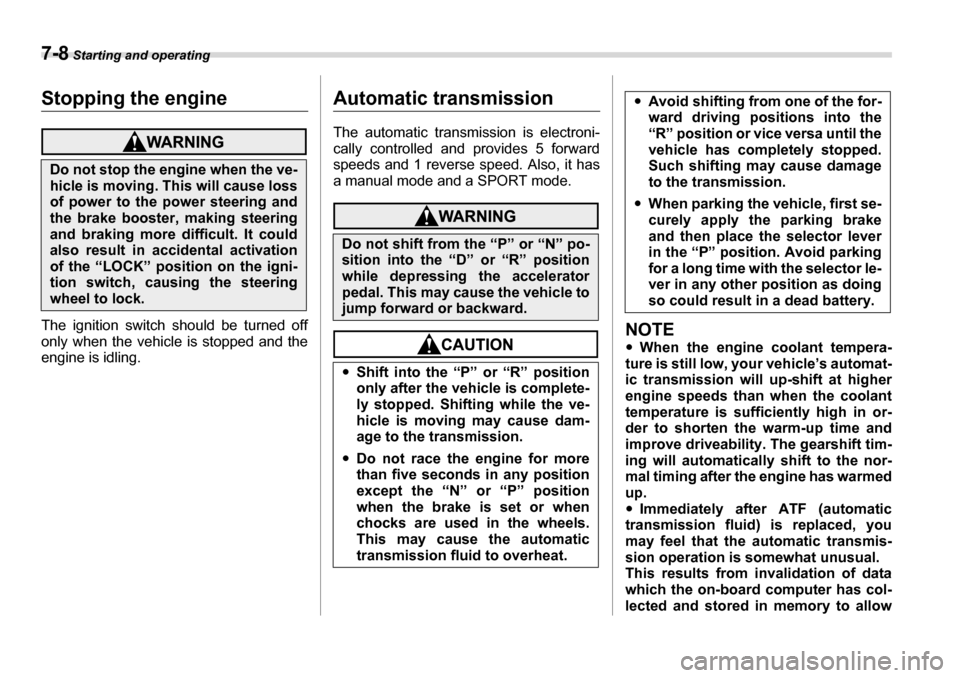
7-8 Starting and operating
Stopping the engine
The ignition switch should be turned off
only when the vehicle is stopped and the
engine is idling.
Automatic transmission
The automatic transmission is electroni-
cally controlled and provides 5 forward
speeds and 1 reverse speed. Also, it has
a manual mode and a SPORT mode.
NOTE �yWhen the engine coolant tempera-
ture is still low, your vehicle’s automat-
ic transmission will up-shift at higher
engine speeds than when the coolant
temperature is sufficiently high in or-
der to shorten the warm-up time and
improve driveability. The gearshift tim-
ing will automatically shift to the nor-
mal timing after the engine has warmed
up.�y Immediately after ATF (automatic
transmission fluid) is replaced, you
may feel that the automatic transmis-
sion operation is somewhat unusual.
This results from invalidation of data
which the on-board computer has col-
lected and stored in memory to allow
Do not stop the engine when the ve-
hicle is moving. This will cause loss
of power to the power steering and
the brake booster, making steering
and braking more difficult. It could
also result in accidental activation
of the “LOCK” position on the igni-
tion switch, causing the steering
wheel to lock.
Do not shift from the “P” or “N” po-
sition into the “D” or “R” position
while depressing the accelerator
pedal. This may cause the vehicle to
jump forward or backward. �y Shift into the “P” or “R” position
only after the vehicle is complete-
ly stopped. Shifting while the ve-
hicle is moving may cause dam-
age to the transmission.
�y Do not race the engine for more
than five seconds in any position
except the “N” or “P” position
when the brake is set or when
chocks are used in the wheels.
This may cause the automatic
transmission fluid to overheat.
�yAvoid shifting from one of the for-
ward driving positions into the
“R” position or vice versa until the
vehicle has completely stopped.
Such shifting may cause damage
to the transmission.
�y When parking the vehicle, first se-
curely apply the parking brake
and then place the selector lever
in the “P” position. Avoid parking
for a long time with the selector le-
ver in any other position as doing
so could result in a dead battery.
Page 224 of 377
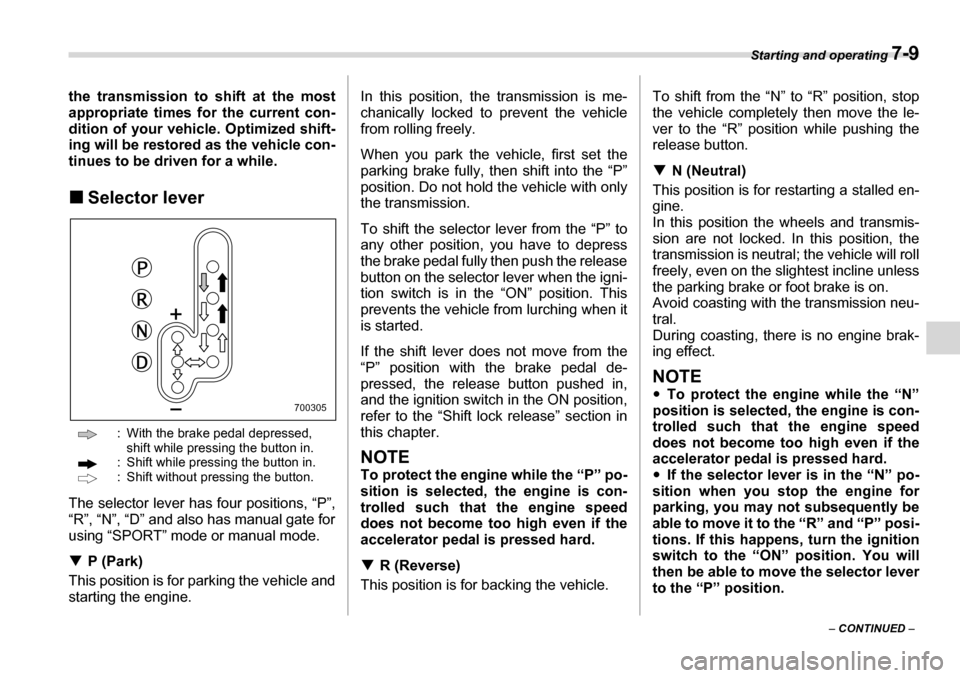
Starting and operating 7-9
– CONTINUED –
the transmission to shift at the most
appropriate times for the current con-
dition of your vehicle. Optimized shift-
ing will be restored as the vehicle con-
tinues to be driven for a while. �„
Selector lever
: With the brake pedal depressed, shift while pressing the button in.
: Shift while pressing the button in.
: Shift without pressing the button.
The selector lever has four positions, “P”,
“R”, “N”, “D” and also has manual gate for
using “SPORT” mode or manual mode. �T P (Park)
This position is for parking the vehicle and
starting the engine. In this position, the transmission is me-
chanically locked to prevent the vehicle
from rolling freely.
When you park the vehicle, first set the
parking brake fully, then shift into the “P”
position. Do not hold the vehicle with onlythe transmission.
To shift the selector lever from the “P” to
any other position, you have to depress
the brake pedal fully then push the release
button on the selector lever when the igni-
tion switch is in the “ON” position. This
prevents the vehicle from lurching when it
is started.
If the shift lever does not move from the
“P” position with the brake pedal de-
pressed, the release button pushed in,
and the ignition switch in the ON position,
refer to the “Shift lock release” section in
this chapter.
NOTE
To protect the engine while the “P” po-
sition is selected, the engine is con-
trolled such that the engine speed
does not become too high even if the
accelerator pedal is pressed hard. �T
R (Reverse)
This position is for backing the vehicle. To shift from the “N” to “R” position, stop
the vehicle completely then move the le-
ver to the “R” position while pushing the
release button. �T
N (Neutral)
This position is for restarting a stalled en-
gine.
In this position the wheels and transmis-
sion are not locked. In this position, the
transmission is neutral; the vehicle will roll
freely, even on the slightest incline unless
the parking brake or foot brake is on.
Avoid coasting with the transmission neu-tral.
During coasting, there is no engine brak-
ing effect.
NOTE �y To protect the engine while the “N”
position is selected, the engine is con-
trolled such that the engine speed
does not become too high even if the
accelerator pedal is pressed hard.�y If the selector lever is in the “N” po-
sition when you stop the engine for
parking, you may not subsequently be
able to move it to the “R” and “P” posi-
tions. If this happens, turn the ignition
switch to the “ON” position. You will
then be able to move the selector lever
to the “P” position.
700305
Page 225 of 377
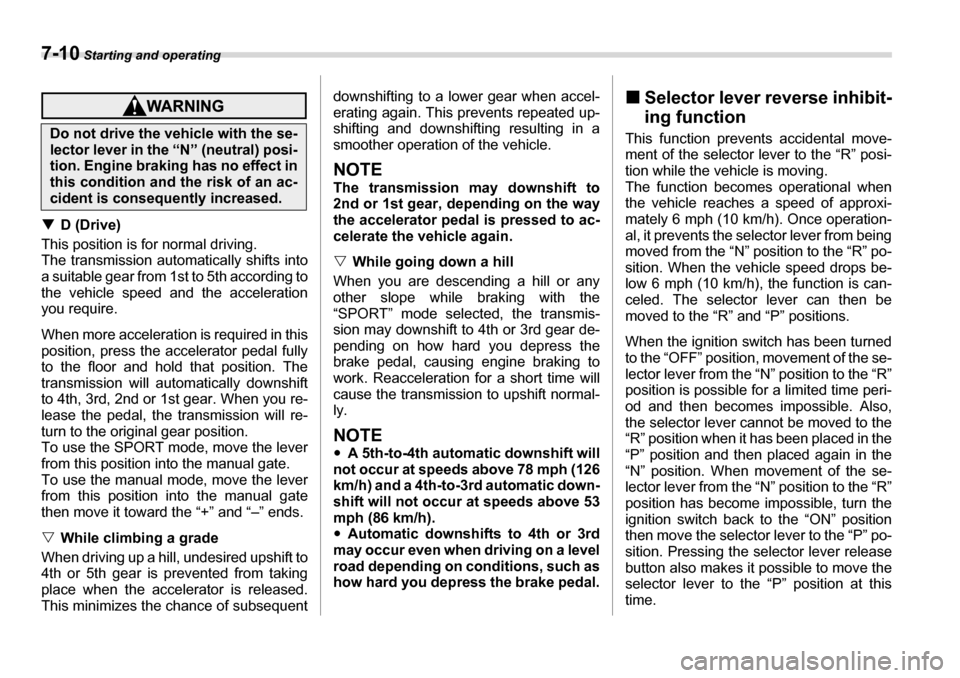
7-10 Starting and operating
�TD (Drive)
This position is for normal driving.
The transmission automatically shifts into
a suitable gear from 1st to 5th according to
the vehicle speed and the acceleration
you require.
When more acceleration is required in this
position, press the accelerator pedal fully
to the floor and hold that position. The
transmission will automatically downshift
to 4th, 3rd, 2nd or 1st gear. When you re-
lease the pedal, the transmission will re-
turn to the original gear position.
To use the SPORT mode, move the lever
from this position into the manual gate.
To use the manual mode, move the lever
from this position into the manual gate
then move it toward the “+” and “–” ends. �V While climbing a grade
When driving up a hill, undesired upshift to
4th or 5th gear is prevented from taking
place when the accelerator is released.
This minimizes the chance of subsequent downshifting to a lower gear when accel-
erating again. This prevents repeated up-
shifting and downshifting resulting in a
smoother operation of the vehicle.
NOTE
The transmission may downshift to
2nd or 1st gear, depending on the way
the accelerator pedal is pressed to ac-
celerate the vehicle again. �V
While going down a hill
When you are descending a hill or any
other slope while braking with the “SPORT” mode selected, the transmis-
sion may downshift to 4th or 3rd gear de-
pending on how hard you depress the
brake pedal, causing engine braking to
work. Reacceleration for a short time will
cause the transmission to upshift normal- ly.
NOTE �y A 5th-to-4th automatic downshift will
not occur at speeds above 78 mph (126
km/h) and a 4th-to-3rd automatic down-
shift will not occur at speeds above 53
mph (86 km/h).�y Automatic downshifts to 4th or 3rd
may occur even when driving on a level
road depending on conditions, such as
how hard you depress the brake pedal. �„
Selector lever reverse inhibit-
ing function
This function prevents accidental move-
ment of the selector lever to the “R” posi-
tion while the vehicle is moving.
The function becomes operational when
the vehicle reaches a speed of approxi-
mately 6 mph (10 km/h). Once operation-
al, it prevents the selector lever from being
moved from the “N” position to the “R” po-
sition. When the vehicle speed drops be-
low 6 mph (10 km/h), the function is can-
celed. The selector lever can then be
moved to the “R” and “P” positions.
When the ignition switch has been turned
to the “OFF” position, movement of the se-
lector lever from the “N” position to the “R”
position is possible for a limited time peri-
od and then becomes impossible. Also,
the selector lever cannot be moved to the
“R” position when it has been placed in the
“P” position and then placed again in the
“N” position. When movement of the se-
lector lever from the “N” position to the “R”
position has become impossible, turn the
ignition switch back to the “ON” position
then move the selector lever to the “P” po-
sition. Pressing the selector lever release
button also makes it possible to move the
selector lever to the “P” position at this
time.
Do not drive the vehicle with the se-
lector lever in the “N” (neutral) posi-
tion. Engine braking has no effect in
this condition and the risk of an ac-
cident is consequently increased.
Page 227 of 377
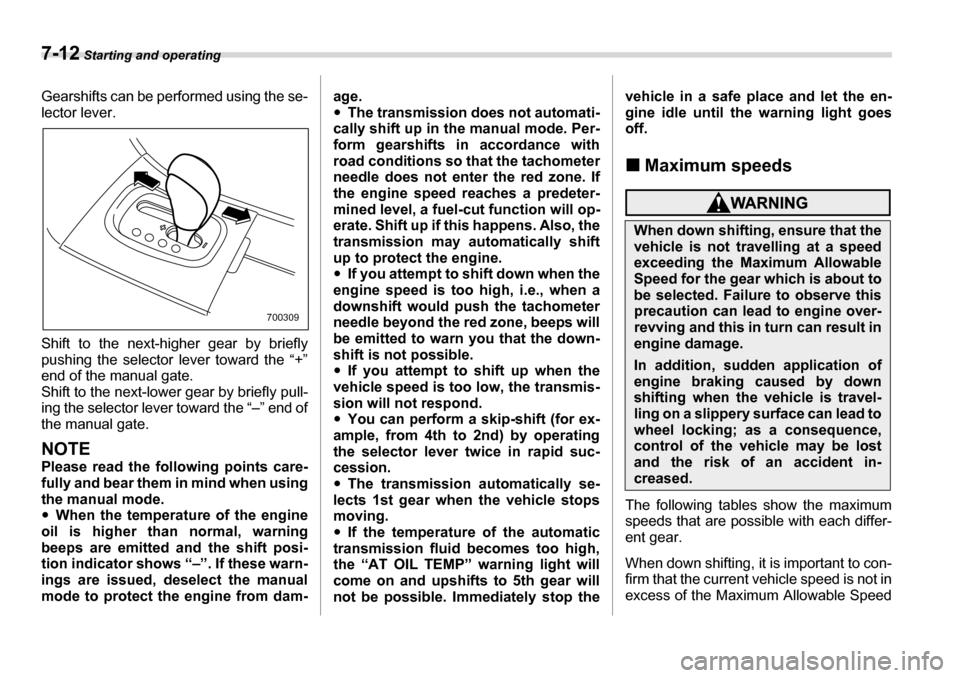
7-12 Starting and operating
Gearshifts can be performed using the se-
lector lever.
Shift to the next-higher gear by briefly
pushing the selector lever toward the “+”
end of the manual gate.
Shift to the next-lower gear by briefly pull-
ing the selector lever toward the “–” end of
the manual gate.
NOTE
Please read the following points care-
fully and bear them in mind when usingthe manual mode. �yWhen the temperature of the engine
oil is higher than normal, warning
beeps are emitted and the shift posi-
tion indicator shows “–”. If these warn-
ings are issued, deselect the manual
mode to protect the engine from dam- age. �y
The transmission does not automati-
cally shift up in the manual mode. Per-
form gearshifts in accordance with
road conditions so that the tachometer
needle does not enter the red zone. If
the engine speed reaches a predeter-
mined level, a fuel-cut function will op-
erate. Shift up if this happens. Also, the
transmission may automatically shift
up to protect the engine. �y If you attempt to shift down when the
engine speed is too high, i.e., when a
downshift would push the tachometer
needle beyond the red zone, beeps will
be emitted to warn you that the down-
shift is not possible. �y If you attempt to shift up when the
vehicle speed is too low, the transmis-
sion will not respond. �y You can perform a skip-shift (for ex-
ample, from 4th to 2nd) by operating
the selector lever twice in rapid suc-
cession. �y The transmission automatically se-
lects 1st gear when the vehicle stops
moving. �y If the temperature of the automatic
transmission fluid becomes too high,
the “AT OIL TEMP” warning light will
come on and upshifts to 5th gear will
not be possible. Immediately stop the vehicle in a safe place and let the en-
gine idle until the warning light goes off.
�„ Maximum speeds
The following tables show the maximum
speeds that are possible with each differ- ent gear.
When down shifting, it is important to con-
firm that the current vehicle speed is not in
excess of the Maximum Allowable Speed
700309
When down shifting, ensure that the
vehicle is not travelling at a speed
exceeding the Maximum Allowable
Speed for the gear which is about to
be selected. Failure to observe this
precaution can lead to engine over-
revving and this in turn can result in
engine damage.
In addition, sudden application of
engine braking caused by down
shifting when the vehicle is travel-
ling on a slippery surface can lead to
wheel locking; as a consequence,
control of the vehicle may be lost
and the risk of an accident in-
creased.
Page 237 of 377
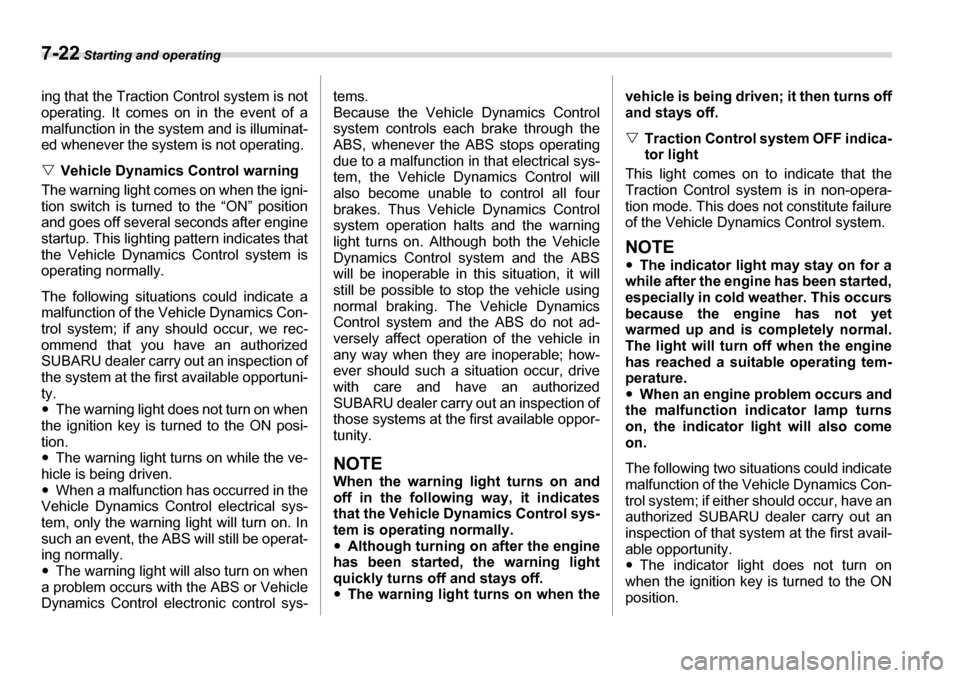
7-22 Starting and operating
ing that the Traction Control system is not
operating. It comes on in the event of a
malfunction in the system and is illuminat-
ed whenever the system is not operating. �VVehicle Dynamics Control warning
The warning light comes on when the igni-
tion switch is turned to the “ON” position
and goes off several seconds after engine
startup. This lighting pattern indicates that
the Vehicle Dynamics Control system is
operating normally.
The following situations could indicate a
malfunction of the Vehicle Dynamics Con-
trol system; if any should occur, we rec-
ommend that you have an authorized
SUBARU dealer carry out an inspection of
the system at the first available opportuni-ty. �y The warning light does not turn on when
the ignition key is turned to the ON posi- tion. �y The warning light turns on while the ve-
hicle is being driven. �y When a malfunction has occurred in the
Vehicle Dynamics Control electrical sys-
tem, only the warning light will turn on. In
such an event, the ABS will still be operat-
ing normally. �y The warning light will also turn on when
a problem occurs with the ABS or Vehicle
Dynamics Control electronic control sys- tems.
Because the Vehicle Dynamics Control
system controls each brake through the
ABS, whenever the ABS stops operating
due to a malfunction in that electrical sys-
tem, the Vehicle Dynamics Control will
also become unable to control all four
brakes. Thus Vehicle Dynamics Control
system operation halts and the warning
light turns on. Although both the Vehicle
Dynamics Control system and the ABS
will be inoperable in this situation, it will
still be possible to stop the vehicle using
normal braking. The Vehicle Dynamics
Control system and the ABS do not ad-
versely affect operation of the vehicle in
any way when they are inoperable; how-
ever should such a situation occur, drive
with care and have an authorized
SUBARU dealer carry out an inspection of
those systems at the first available oppor-
tunity.
NOTE
When the warning light turns on and
off in the following way, it indicates
that the Vehicle Dynamics Control sys-
tem is operating normally. �y
Although turning on after the engine
has been started, the warning light
quickly turns off and stays off. �y The warning light turns on when the vehicle is being driven; it then turns off
and stays off. �V
Traction Control system OFF indica- tor light
This light comes on to indicate that the
Traction Control system is in non-opera-
tion mode. This does not constitute failure
of the Vehicle Dynamics Control system.
NOTE �y The indicator light may stay on for a
while after the engine has been started,
especially in cold weather. This occurs
because the engine has not yet
warmed up and is completely normal.
The light will turn off when the engine
has reached a suitable operating tem-
perature. �y When an engine problem occurs and
the malfunction indicator lamp turns
on, the indicator light will also come
on.
The following two situations could indicate
malfunction of the Vehicle Dynamics Con-
trol system; if either should occur, have an
authorized SUBARU dealer carry out an
inspection of that system at the first avail-
able opportunity. �y The indicator light does not turn on
when the ignition key is turned to the ON
position.
Page 256 of 377
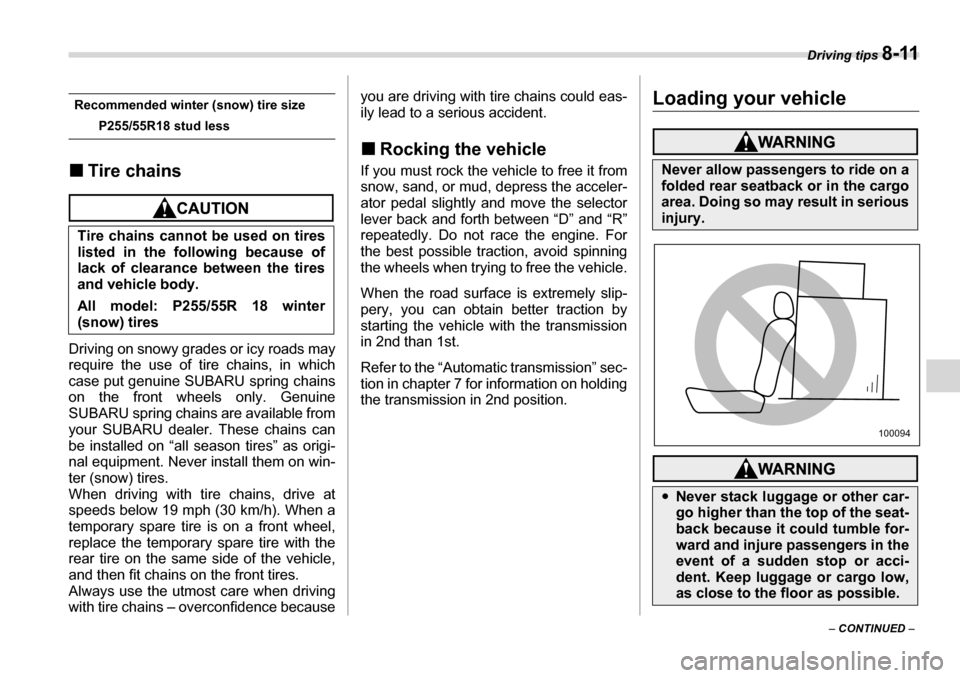
Driving tips 8-11
– CONTINUED –
Recommended winter (snow) tire size
P255/55R18 stud less
�„ Tire chains
Driving on snowy grades or icy roads may
require the use of tire chains, in which
case put genuine SUBARU spring chains
on the front wheels only. Genuine
SUBARU spring chains are available from
your SUBARU dealer. These chains can
be installed on “all season tires” as origi-
nal equipment. Never install them on win- ter (snow) tires.
When driving with tire chains, drive at
speeds below 19 mph (30 km/h). When a
temporary spare tire is on a front wheel,
replace the temporary spare tire with the
rear tire on the same side of the vehicle,
and then fit chains on the front tires.
Always use the utmost care when driving
with tire chains – overconfidence because you are driving with tire chains could eas-
ily lead to a serious accident. �„
Rocking the vehicle
If you must rock the vehicle to free it from
snow, sand, or mud, depress the acceler-
ator pedal slightly and move the selector
lever back and forth between “D” and “R”
repeatedly. Do not race the engine. For
the best possible traction, avoid spinning
the wheels when trying to free the vehicle.
When the road surface is extremely slip-
pery, you can obtain better traction by
starting the vehicle with the transmission
in 2nd than 1st.
Refer to the “Automatic transmission” sec-
tion in chapter 7 for information on holding
the transmission in 2nd position.
Loading your vehicle
Tire chains cannot be used on tires
listed in the following because of
lack of clearance between the tires
and vehicle body.
All model: P255/55R 18 winter (snow) tires
Never allow passengers to ride on a
folded rear seatback or in the cargo
area. Doing so may result in serious
injury.
�y Never stack luggage or other car-
go higher than the top of the seat-
back because it could tumble for-
ward and injure passengers in the
event of a sudden stop or acci-
dent. Keep luggage or cargo low,
as close to the floor as possible.
100094
Page 359 of 377
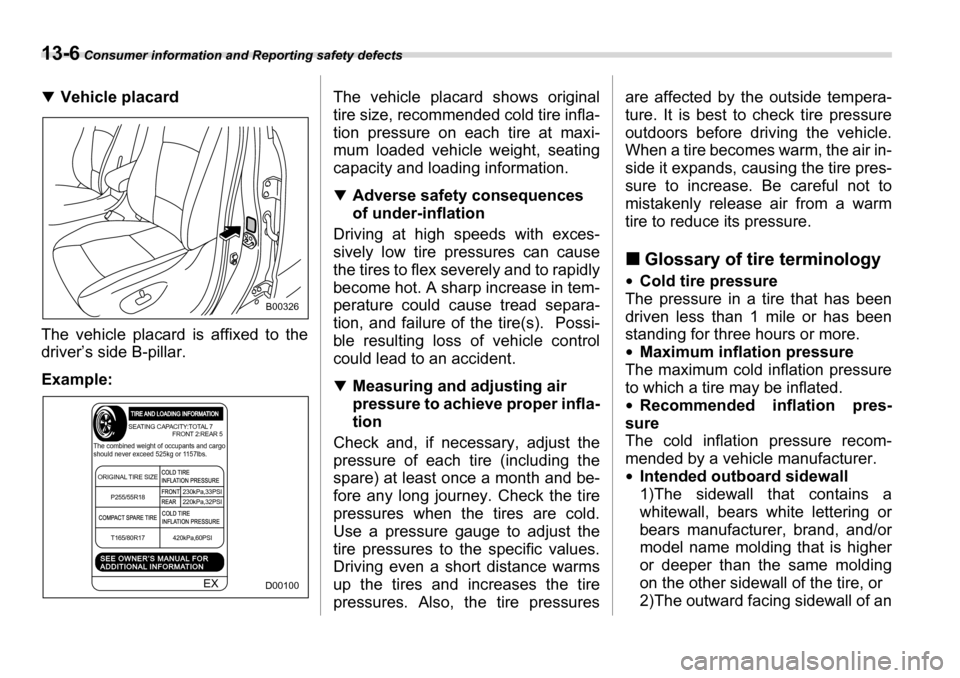
13-6 Consumer information and Reporting safety defects
�TVehicle placard
The vehicle placard is affixed to the
driver’s side B-pillar. Example: The vehicle placard shows original
tire size, recommended cold tire infla-
tion pressure on each tire at maxi-
mum loaded vehicle weight, seating
capacity and loading information. �T
Adverse safety consequences
of under-inflation
Driving at high speeds with exces-
sively low tire pressures can cause
the tires to flex severely and to rapidly
become hot. A sharp increase in tem-
perature could cause tread separa-
tion, and failure of the tire(s). Possi-
ble resulting loss of vehicle control
could lead to an accident. �T Measuring and adjusting air
pressure to achieve proper infla-
tion
Check and, if necessary, adjust the
pressure of each tire (including the
spare) at least once a month and be-
fore any long journey. Check the tire
pressures when the tires are cold.
Use a pressure gauge to adjust the
tire pressures to the specific values.
Driving even a short distance warms
up the tires and increases the tire
pressures. Also, the tire pressures are affected by the outside tempera-
ture. It is best to check tire pressure
outdoors before driving the vehicle.
When a tire becomes warm, the air in-
side it expands, causing the tire pres-
sure to increase. Be careful not to
mistakenly release air from a warm
tire to reduce its pressure. �„
Glossary of tire terminology
�y Cold tire pressure
The pressure in a tire that has been
driven less than 1 mile or has been
standing for three hours or more. �y Maximum inflation pressure
The maximum cold inflation pressure
to which a tire may be inflated. �y Recommended inflation pres-
sure
The cold inflation pressure recom-
mended by a vehicle manufacturer. �y Intended outboard sidewall
1)The sidewall that contains a
whitewall, bears white lettering or
bears manufacturer, brand, and/or
model name molding that is higher
or deeper than the same molding
on the other sidewall of the tire, or
2)The outward facing sidewall of an
B00326
TIREAND LOADING INFORMAANDLOADINGINFORMATIONSEATING CAPACITY:TOTAL 7
ORIGINAL TIRE SIZE COLD TIRE
INFLATION PRESSURE
COLD TIRE
INFLATION PRESSURE
FRONT
230kPa,33PSI
REAR 220kPa,32PSI
P255/55R18
T165/80R17 420kPa,60PSI
COMPACT SPARE TIRE FRONT 2:REAR 5
The combined weight of occupants and cargo
should never exceed 525kg or 1157lbs.
SEE OWNER’S MANUALSEE OWNER’S MANUAL FOR FORADDITIONALADDITIONAL INFORMA INFORMATIONTION
EXD00100